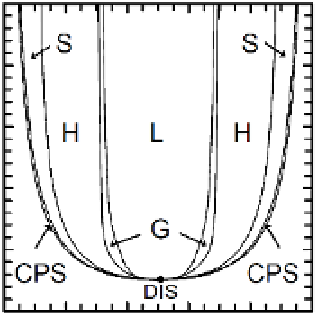Biomedical Engineering Reference
In-Depth Information
The corresponding free energy of the lamellar phase can be used to
estimate the order-disorder boundary. The free energy per chain in
a homogeneous disordered phase (
F
) can be approximated simply
DIS
by the A-B contact energy:
F
DIS
≈
χ f
f
N
=
χN
/4
(2.6)
k
T
A
B
B
χN ~
Setting
10.5 as the
location of the order-disorder transition. From this simple argument
(in good agreement with more rigorous mean field calculations),
we find that symmetric diblocks of high molecular weight or with
strong incompatibility (
F
=
F
(
λ
) predicts a critical value of
DIS
LAM
0
> 10.5) are predicted to microphase
separate into ordered lamellae with a period that scales as the two-
thirds power of the molecular weight. Smaller diblocks, on the other
hand, with more compatible blocks (
χN
χN
< 10.5), are expected to form
a single homogeneous phase.
100
80
60
Χ
N
40
20
0
0
0.2
0.4
0.6
0.8
1
f
Figure 2.4
Diblock copolymer phase diagram parameterized by
f
and
χN
,
calculated by Cochran
et al.
Reproduced with permission from Ref. [6].
More sophisticated mean-field and analytical theories have
been developed to describe microphase separation [4, 5]. Three
regimes are generally defined according to the extent of segregation
(or “degree of incompatibility”) of the blocks: weak (
χN
~ 10),
χN
intermediate (
≥ 100). The above
discussion applies, strictly speaking, to the strong segregation
~ 10−100), and strong (
χN










Search WWH ::

Custom Search